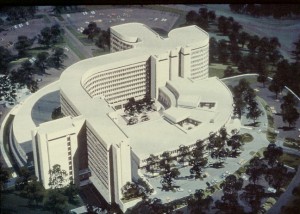
This story is the first of a multi-part series on the history of the Health Center. The entire series can be read at the Health Center’s 50th Anniversary website.
Many people now living in Connecticut probably don’t remember a time when the University of Connecticut Health Center didn’t exist. We’re used to seeing that distinctive building on its Farmington hilltop, visible from miles around. We take for granted that our bright young people have the opportunity to attend nationally renowned public schools of medicine and dental medicine. When we read about amazing research taking place at the Health Center, we’re not surprised. And when we have a medical or dental problem, we’re accustomed to having an abundance of expert professionals close to home to care for us.
Yet the UConn Health Center, which has become so much a part of the fabric of our lives, exists today only because 50 years ago a group of people foresaw what a profound, positive effect such an institution would have on the people of our state. Now, the 50th anniversary of its founding, is the perfect time to take a fresh look at the Health Center—its origins, its accomplishments and the countless ways it enhances the quality of life in Connecticut.
Born to Meet Connecticut’s Needs
The UConn Health Center dates its founding from 1961, when the Connecticut General Assembly passed Special Act 328, authorizing funding for the University of Connecticut to establish a medical and dental school in Hartford County. But the idea had been under discussion since at least the mid-1940s, with several studies having been conducted, and with governors, the University’s board of trustees and presidents, the state Board of Education and the Connecticut State Medical Society all voicing support.
Heroism in the Nick of Time
The story may be apocryphal, but it’s said that the bill creating the University’s medical and dental schools was passed in 1961 thanks to a heroic act by a supportive legislator. In the closing hours of the General Assembly session, so the story goes, a legislator who opposed the bill because of his loyalty to another university snatched the bill and hid it in the pocket of his suit coat, which he then hung in the men’s lavatory. Another legislator, Helen Loy, a strong supporter of the schools, dashed into the men’s room, grabbed the bill and got it to the floor in time for a last-minute vote. The bill became law.
At the national level, after World War II, there was growing concern about a looming physician shortage. The nation’s rapidly growing population was far outstripping the number of physicians graduating from existing medical schools. In its influential 1959 report, Physicians for a Growing America, also known as the Bane Report, the U.S. Department of Health, Education and Welfare called for the creation of 21 new medical schools, one of which it said should be located in Connecticut. This gave further impetus to the idea of founding such a school in the state.
The most compelling reason to create such a school in Connecticut, however, was that Connecticut residents were at a disadvantage when it came to enrolling in medical school. Yale drew from a national pool of applicants, accepting only 10 or 12 Connecticut students annually. State schools in other regions gave preference to their own residents, usually limiting out-of-state students to roughly 15 percent of the class. Plus, as a Connecticut newspaper of the time noted, many private schools across the country restricted the number of religious and ethnic minorities they would accept, putting these Connecticut residents at even further disadvantage. If Connecticut’s bright young people were to have the opportunity to become physicians and dentists and go on to care for state residents, the state would need to establish its own schools. With the passage of Special Act 328, that process got under way.


